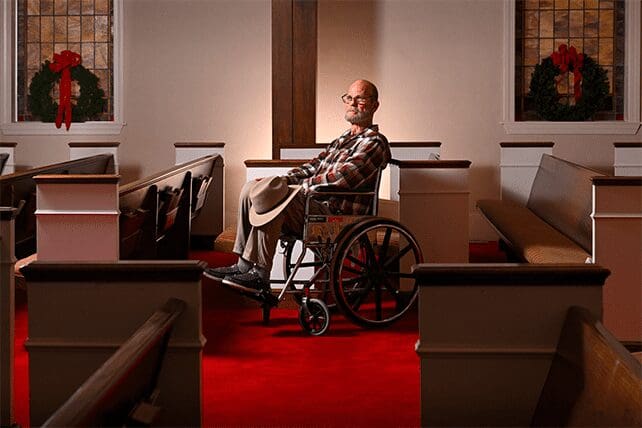NASHVILLE, Tennessee (AP) — Jerry Lamb could not maneuver his wheelchair into the rows of pews at his church. It wouldn’t fit. Nor could he sit in the aisles without awkwardly blocking the way.
So he adapted. It’s a regular part of his new life with limited mobility that requires near-constant calculations of how to navigate a world no longer set up for him. That included his longtime church in Camden, Tennessee – one of the many U.S. houses of worship with accessibility limitations.
Instead, on Sundays, he worshipped in the narthex at the back of Camden First United Methodist Church, separated from the rest of the congregation, with his family at his side in folding chairs. It didn’t really bother Lamb, 66, who “was already over it,” having struggled to walk since 2019 due to a worsening spine condition.
But it bothered the Rev. Adam Kelchner, the new pastor: “I was preaching one Sunday and was rather distraught that one of our families literally could not be in the same worship space just because we didn’t have a seating arrangement that made sense.”
So Kelchner made one that did. He secured trustees’ approval and hired a company to cut up a few pews, making space for Lamb — and anyone else using a wheelchair or walker – to worship alongside the rest of the congregation.
“It blew us out of the water,” said Lamb.
Except as employers, religious entities are exempt from the Americans with Disabilities Act, the 32-year-old landmark civil rights law that included access requirements for public spaces. Nonetheless, most have made their buildings accessible in some fashion.
But there is much room for improvement, said Scott Thumma, a sociology of religion professor and director of the Hartford Institute for Religion Research.
Thumma also co-leads Faith Communities Today, a research project that surveyed more than 15,000 U.S. religious congregations for its 2020 report and found that 76% have wheelchair access. Thirty percent offer large-print worship materials and about the same portion have hearing assistive devices.
“That’s not terrible. But then when you start to ask the questions of how are they accommodating all the other challenges and disabilities? …Then it just almost drops off,” Thumma said. “They don’t make the full accommodations to allow all of their people to actually worship to their fullest in the service.”
The pandemic and the sweeping rise of online worship that followed was a catalyst for a more expansive understanding of what it really means to be an accessible church, said the Rev. Kelly Colwell, who leads digital and hybrid ministry at First Congregational Church of Berkeley, United Church of Christ, in California.
She had an eye-opening virtual coffee chat early in the pandemic. A congregant with multiple sclerosis explained how her online event-packed calendar finally allowed her to participate in ways her physical condition wouldn’t otherwise permit. It made Colwell realize the church had been excluding people with accessibility challenges all along.
Today, Colwell continues to assess whether the church is physically accessible to all congregants on an equal basis. Now she also considers how to make the online and hybrid experience meaningful.
“We’re not providing a sort of separate and unequal service for people who can’t come in person,” Colwell said.
Maria Town, the American Association of People with Disabilities’ president and CEO, has seen progress. She pointed to congregations adding inclusion events and playgrounds for all as well as an activist-created, easy-to-read Quran translation for those with intellectual and developmental disabilities.
“It’s slow, but I do think more and more entities are beginning to realize that this is a need, and I also hope that more and more people with disabilities are actually saying, ‘We deserve to be here,'” Town said.
Omer Zaman, a Muslim wheelchair user near Chicago, is one of the disabled faithful pushing for acceptance and accessibility. He focuses on inclusion at mosques as a volunteer and board member with MUHSEN, a nonprofit advocating for accommodations and understanding of disabilities in the Muslim community.
“Individuals with special needs can be on a board. They can contribute. They can give you a perspective,” said Zaman, 37, who has muscular dystrophy. “We are not defined by our special needs. It’s just a part of who we are … but there’s more to us than that.”
MUHSEN recognizes mosques making progress through its tiered masjid certification. To earn it, they must meet requirements like having disability awareness events, support groups, specialized childcare, braille Qurans and ramps.
“It’s not just the ramp,” said Jerry Lamb, who has confronted accessibility problems in many types of venues.

